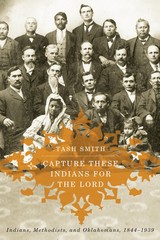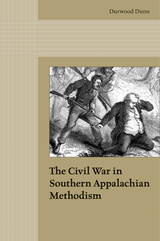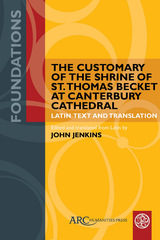2 books about Methodist Episcopal Church, South

Capture These Indians for the Lord
Indians, Methodists, and Oklahomans, 1844-1939
Tash Smith
University of Arizona Press, 2014
In 1844, on the heels of the final wave of the forced removal of thousands of Indians from the southern United States to what is now Oklahoma, the Southern Methodist Church created a separate organization known as the Indian Mission Conference to oversee its missionary efforts among the Native communities of Indian Territory. Initially, the Church conducted missions as part of the era’s push toward assimilation. But what the primarily white missionaries quickly encountered was a population who exerted more autonomy than they expected and who used Christianity to protect their culture, both of which frustrated those eager to bring Indian Territory into what they felt was mainstream American society.
In Capture These Indians for the Lord, Tash Smith traces the trajectory of the Southern Methodist Church in Oklahoma when it was at the frontlines of the relentless push toward western expansion. Although many Native people accepted the missionaries’ religious practices, Smith shows how individuals found ways to reconcile the Methodist force with their traditional cultural practices. When the white population of Indian Territory increased and Native sovereignty came under siege during the allotment era of the 1890s, white communities marginalized Indians within the Church and exploited elements of mission work for their own benefit.
Later, with white indifference toward Indian missions peaking in the early twentieth century, Smith explains that as the remnants of the Methodist power weakened, Indian membership regained control and used the Church to regenerate their culture. Throughout, Smith explores the complex relationships between white and Indian community members and how these phenomena shaped Methodist churches in the twentieth century.
In Capture These Indians for the Lord, Tash Smith traces the trajectory of the Southern Methodist Church in Oklahoma when it was at the frontlines of the relentless push toward western expansion. Although many Native people accepted the missionaries’ religious practices, Smith shows how individuals found ways to reconcile the Methodist force with their traditional cultural practices. When the white population of Indian Territory increased and Native sovereignty came under siege during the allotment era of the 1890s, white communities marginalized Indians within the Church and exploited elements of mission work for their own benefit.
Later, with white indifference toward Indian missions peaking in the early twentieth century, Smith explains that as the remnants of the Methodist power weakened, Indian membership regained control and used the Church to regenerate their culture. Throughout, Smith explores the complex relationships between white and Indian community members and how these phenomena shaped Methodist churches in the twentieth century.
[more]

The Civil War in Southern Appalachian Methodism
Durwood Dunn
University of Tennessee Press, 2014
The Civil War in Southern Appalachian Methodism addresses a much-neglected topic in both Appalachian and Civil War history—the role of organized religion in the sectional strife and the war itself. Meticulously researched, well written, and full of fresh facts, this new book brings an original perspective to the study of the conflict and the region.
In many important respects, the actual Civil War that began in 1861 unveiled an internal civil war within the Holston Conference of the Methodist Episcopal Church, South—comprising churches in southwestern Virginia, eastern Tennessee, western North Carolina, and a small portion of northern Georgia—that had been waged surreptitiously for the previous five decades. This work examines the split within the Methodist Church that occurred with mounting tensions over the slavery question and the rise of the Confederacy. Specifically, it looks at how the church was changing from its early roots as a reform movement grounded in a strong local pastoral ministry to a church with a more intellectual, professionalized clergy that often identified with Southern secessionists.
The author has mined an exhaustive trove of primary sources, especially the extensive, yet often-overlooked minutes from frequent local and regional Methodist gatherings. He has also explored East Tennessee newspapers and other published works on the topic. The author’s deep research into obscure church records and other resources results not only in a surprising interpretation of the division within the Methodist Church but also new insights into the roles of African Americans, women, and especially lay people and local clergy in the decades prior to the war and through its aftermath. In addition, Dunn presents important information about what the inner Civil War was like in East Tennessee, an area deeply divided between Union and Confederate sympathizers.
Students and scholars of religious history, southern history, and Appalachian studies will be enlightened by this volume and its bold new way of looking at the history of the Methodist Church and this part of the nation.
In many important respects, the actual Civil War that began in 1861 unveiled an internal civil war within the Holston Conference of the Methodist Episcopal Church, South—comprising churches in southwestern Virginia, eastern Tennessee, western North Carolina, and a small portion of northern Georgia—that had been waged surreptitiously for the previous five decades. This work examines the split within the Methodist Church that occurred with mounting tensions over the slavery question and the rise of the Confederacy. Specifically, it looks at how the church was changing from its early roots as a reform movement grounded in a strong local pastoral ministry to a church with a more intellectual, professionalized clergy that often identified with Southern secessionists.
The author has mined an exhaustive trove of primary sources, especially the extensive, yet often-overlooked minutes from frequent local and regional Methodist gatherings. He has also explored East Tennessee newspapers and other published works on the topic. The author’s deep research into obscure church records and other resources results not only in a surprising interpretation of the division within the Methodist Church but also new insights into the roles of African Americans, women, and especially lay people and local clergy in the decades prior to the war and through its aftermath. In addition, Dunn presents important information about what the inner Civil War was like in East Tennessee, an area deeply divided between Union and Confederate sympathizers.
Students and scholars of religious history, southern history, and Appalachian studies will be enlightened by this volume and its bold new way of looking at the history of the Methodist Church and this part of the nation.
[more]
READERS
Browse our collection.
PUBLISHERS
See BiblioVault's publisher services.
STUDENT SERVICES
Files for college accessibility offices.
UChicago Accessibility Resources
home | accessibility | search | about | contact us
BiblioVault ® 2001 - 2024
The University of Chicago Press









